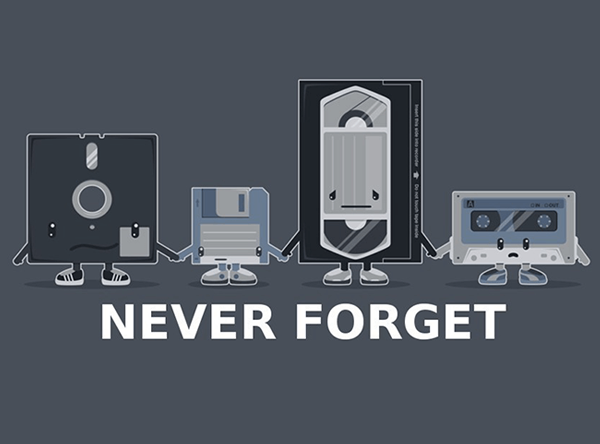When Gordon E. Moore, a Fairchild Semiconductor director of research and development (R&D), was asked to provide a forecast for the next 10 years as a technologist, he said that the capacity of integrated circuits would double every two years.
(Read more about Cloud Backup Services in Toronto)
This prediction was popularized and coined, Moore’s Law, and it had widespread technological consequences, insofar that it signaled an exponential growth in the technology sector that was lightning-fast. Moore was merely theorizing at the time, but his statement is now seen as a truism that has withstood the test of time. The evolution of storage strongly underscores the vibrancy of Moore’s Law.
More importantly, Moore also had foreseen, moreso than merely estimating and speculating, the incredible innovative waves that were being funnelled into computer systems and components and how they were going to continue in the future. Through entrepreneurial pushes and scientific discoveries, computers were at the apex of technological wizardly and were unparalleled in any other technological industry. Moore had surmised that the future belonged to the computers. In particular, Moore, as someone who was incredibly interested in cores and microprocessors, had seen the path that storage capacity was taking. This article discusses the evolution of storage is of critical importance because it reveals growing industrial and emerging consumer demands that helped steer the technological drivers.
When you trace tech-related development and evolutionary trends, a frame of reference must be qualitatively and qualitatively ascribed to changing consumer trends. This point is particularly relevant when it comes to storage capacities. Consumers have a special affinity and concern when it comes to storage because it holds their information and they see it as an extension of themselves. This fact is amplified because end-users are extremely concerned with when, where and how to access those data sets.
The powerful expression that “knowledge is power” reminds those in the industry that information, and the ability to transmit, share, secure and store it is incredibly important and the primary driver of innovation. The technological explanation is that the upward trend, in both storing capacity and minimalism when it comes to physical space they occupy, has helped manage complexities, has shifted to user-friendliness and has led to autonomic storage. The challenges driving the research and development efforts of storage, backup and security concerns relating to them, come directly from the end-users, who are crucial in driving the next technologies, testing system flaws, and testing the responsiveness of the industry.
When information started to take on an electronic component, it started to gain make evolutionary leaps in a short matter of time. In the 1940s, the Ferrite core was good for storing 4KB of data, which is largely insignificant and almost non-existent by our standards today. In the decade after, data storage got a major boost when IBM, standing for International Business Machines, was able to supercharge it to 220MB. Making great headways, the workforce greatly benefited from this new technology, from car manufacturers to doctors, who were using the storage revolution to fundamentally change the way they went about their work. Philips expanded greatly on the innovations of IBM by creating the WORM (write once read many), which enhanced storing capacity to 5GB. These benefits were largely felt on the business and enterprise front and had not yet really trickled-down to the consumers. The evolution of storage was thus far, pretty elusive to Main St. That was about to change, and once again, IBM had a major role in changing the landscape and leading the charge.
In the 1960s, IBM, who had become industry pioneers in storage, set out to do revolutionized the way consumers’ stored their data. The floppy disk was born. In 1971, IBM made it commercially available to the public. In the 1980s and early 1990s, floppy disks were the preferred choice for people to store their backups, files and documents for the purpose of transferring them later on or using them for personal or business reasons. The floppy disk was everywhere and mostly came in a 1.44MB format.
The floppy disk was king, until the CD (Compact Disc) emerged in the 1990s. It changed the game and floppy disks started to greatly decline by 1998. The watershed moment came when Apple decided to build-in a CD-ROM into their newly-introduced computer, the iMac, and elected to completely omit floppy disk drives for the iMac and all future models. Apple’s intuition that the floppy disk was becoming archaic and obsolete was correct. The omission of the floppy disk had laid the path for the widespread adaptability of CDs, which were rewritable and had, at the time, massive end-user storage potential. The average CD came in 682 MB and 737 MB varieties, which represented an astonishing 5000% increase in storing capacity from its predeceasing technologies.
At the turn of the new millennium, a Singaporean technology company, introduced the highly-innovative and portable USB Flash Drive. The new, finger-sized USB was smaller than any of its predecessors as it could easily fit in your pocket and be put on your keychain. The new medium of storage was also affordably priced, with the first model costing a little less than thirty ($30) dollars. Toshiba build-on the Flash technology and released a 2GB USB Flash Drive in 2003 that showcased the direction that storing power was headed. The language had changed. Consumers were no longer talking about megabytes, they were talking about gigabytes (one gigabyte is 1000 megabytes). People were now putting large files, like films, music and entire computer folders on their drives. The general trend up to this point, was that sizes of storage devices was shrinking from house-sized storage capacities (in the 1950s) to thumb-sized storage power that is superior, more reliable and more stable that the technologies of yesteryears.
In 2007, Hitachi Desktar 7K1000 released the world’s first terabyte (which is 1024 GB of storage) hard disk drive. This fast data-transferring hard disk had not only resulted in an incredible leap in the evolution of storage, it changed expectations of consumers. Perhaps the most evolutionary form of storage technology that has emerged has been the Solid State Disks (SSD), which are non-volatile, data that is persistent and built-in solid-state technologies. Outside the technological leaps that we have seen in the storage realm in the past few decades, on an industrial and consumer front, the dip in pricing for consumers and businesses has also mean that economies of scale have been realized and with it being a multi-billion dollar industry, consumers are greatly fascinated in the direction that storage technologies are heading and the constant evolution of storage seems to be progressing at an accelerating and unstoppable rate.
—
Fidelity IT Solutions provides cloud-based backup services and solutions as well as on-premise backup solutions that will allow you to sleep easy at night. If you are a Toronto small or medium-sized business that needs off-site and on-site backup services, do not hesitate to call us at 647-693-9124 or email us at info@fidelityit.com.





